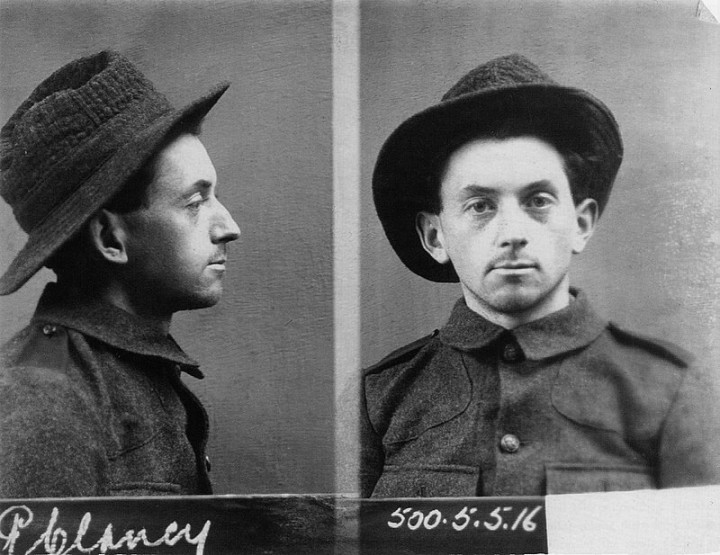


Richmond Barracks is delighted to welcome historian Donal Fallon to write a series of blog posts about the building and its rich history. Today, Donal is taking a look at one of the photos on display in the Barracks.
There is something powerful about Peadar Clancy’s mugshot, taken in the aftermath of the Easter Rising, and which hangs now in the Richmond Barracks gymnasium.
Like a work of art, it can divide opinion. Even among Richmond Barracks guides, some insist there is a fear which can be seen in the eyes of Clancy, while others suggest a great defiance.
This image was taken at the Richmond Barracks in the aftermath of the Rising, during the interrogation of rebel participants. The task of identifying leading protagonists in the Rising fell to the G Division of the Dublin Metropolitan Police, the political intelligence division of the police force in Dublin. Their Movement of Extremist files, which survive today in the National Archives of Ireland, provide comprehensive insight into the revolutionary movement in early twentieth century Dublin.
W.T Cosgrave, later the first political leader of the Free State, remembered that the G Men “entered the gymnasium, walking from one end to the other, studying the prisoners, calling out certain Volunteers to the far side of the hall.” A number of the G Men who identified leading participants in the aftermath of the Rising would be subsequently targeted by the IRA in the War of Independence.
There is much we don’t know about the Richmond Barracks mugshots – why were certain rebels photographed and not others? In 2016, a collection of twelve of these images was auctioned in London. They included men like Piaras Beaslai and J.J Walsh, but not the image of Peadar Clancy. None of the men in the 2016 collection which came to public attention were executed. Those images had been inherited by a relation of a Dublin policeman, and as The Irish Times noted “It is not known how many 1916 rebels’ mugshots were taken nor if other photographs have survived. They may have been destroyed or could have been taken back to England when the British left in 1922 and may be lost or mislaid.”
Peadar Clancy (1888-1920) from Clare had joined the Irish Volunteers at the time of their inception in 1913. During the Rising he served with the Volunteers at the Four Courts, and while sentenced to death following his court-martial appearance, he lived to fight another day, with his sentence commuted. While many of the rebels were released at Christmas 1916, Clancy was detained until June 1917.
Clancy was a significant player in the War of Independence in Dublin, holding the rank of Director of Munitions on the IRA’s General Headquarters.
He was arrested in November 1920, and interrogated at Dublin Castle. Clancy, along with Dick McKee and Conor Clune, two fellow prisoners, died in custody on 21 November 1920. The authorities maintained that Clancy and his fellow prisoners had made a break for it, though this narrative was widely disputed. It occurred on one of the bloodiest days of the Irish revolution in the capital; the day began with the shooting of spies in dawn raids by IRA operatives before a crowd of spectators in Croke Park were fired upon in the evening in what was widely viewed as an act of retaliation. The day would become Bloody Sunday.
Clancy, in his Richmond Barracks mugshot, is a young Volunteer. Whether he appears frightened or defiant remains contested.
We would love to hear from anyone who has additional Richmond Barracks mugshots. They are a key part of the story of the aftermath of the Rising.
You can reach the team at richmondbarracks@dublincitycouncilculturecompany.ie or through our social media channels.
Donal Fallon is a historian, broadcaster and curator from Dublin. Formerly Historian in Residence to Dublin City Council, he is the author of numerous studies of twentieth century Dublin, including The Pillar: The Life and Afterlife of the Nelson Pillar (New Island, 2013). He produces the Three Castles Burning podcast and has contributed to publications including Jacobin, Dublin Historical Review, Saothar and The Irish Times. He is a graduate of Maynooth University, University College Dublin and the Ulster University, and lectures with the Lifelong Learning department of University College Dublin.
Posted 27 April 2020